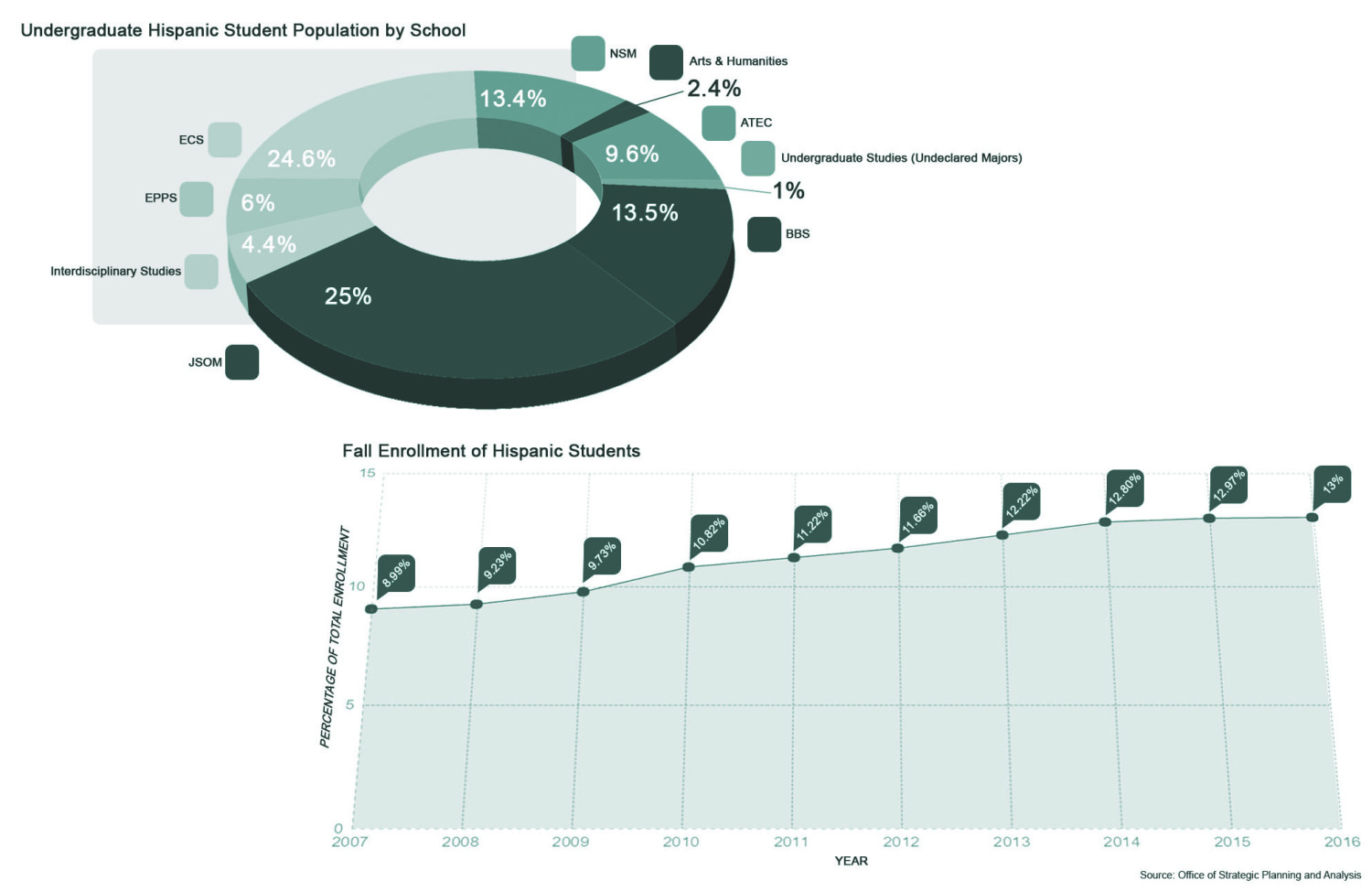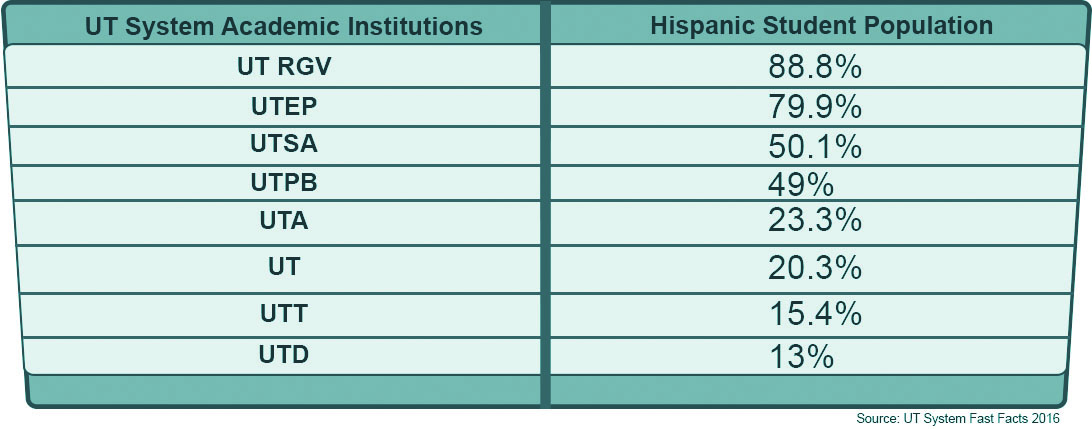Despite Texas having the second largest Hispanic population in the country,
UTD’s Hispanic student enrollment this fall continues the university’s trend from last year of being the lowest ranked among all the UT System academic institutions for Hispanic representation.
With the Hispanic population totaling just 13 percent of student enrollment in fall 2016, the shortage in representation poses a challenge for Hispanic students as they compete with their peers and for the university as a whole.
The Tier One Bias
Raul Hinojosa Jr., the director of Community Engagement, said one of the reasons The University of Texas at Arlington, The University of Texas at El Paso, The University of Texas at San Antonio and The University of Texas at Rio Grande Valley have higher Hispanic populations than UTD is that the schools have a goal to maintain their Hispanic Serving Institution status.
This is a federal distinction for universities where 25 percent of total enrollment, including full-time and part-time students, is Hispanic students.
Although UTA, UTEP and UTSA are aiming to be Tier One along with managing their HSI distinctions, UTD is currently only focused on becoming a Tier One university, Hinojosa said. But, he emphasized, Tier One status and diversity aren’t mutually exclusive.
“It helps with research, it helps with innovation,” he said. “Obviously the more diverse perspectives you have, not just race and ethnicity but gender and country of origin, the more ways that adds to our research mission.”
Hinojosa cited a study done by a non-profit organization called the Institute for Higher Education and Policy, which provided another reason UTD’s Hispanic student population could be lower. Low-income households in that community run on a cash-basis, so student loans — which are usually necessary to cover whatever financial aid doesn’t — are frowned upon.
Tuition and fees per semester as of fall 2015 for UTD were $5,903 — ranked the highest compared to other Texas public universities.
“Even if we offer a financial aid package that covers all your costs or tuition, there may be students who say ‘Well, part of that package is student loans and I don’t want to get into student debt or my family is discouraging me from taking on student loan debt,’” he said.
The Student Perspective
With Hispanic students forming one of the least represented bodies in the student population on campus, students like Junior Cruz, a biology senior, can visibly see the effect. In the School of Natural Sciences and Mathematics, only 13.4 percent of the undergraduates are Hispanic.
“I sometimes feel really ostracized,” he said. “In my science courses, I can point out maybe two or three other Hispanics in the same course. I remember freshman year, I could only point out one other Hispanic person out of 500 students in one big lecture hall. … It can be intimidating just because I can’t relate. Our cultural backgrounds aren’t the same.”
In accounting and finance junior Flor Morales’ experience, Hispanic students are usually first-generation college students whose parents aren’t able to help them make the most of their college education, which puts them on an uneven playing field.
“Not having a definitive answer to where you’re going kind of makes you feel like you’re alone,” she said. “You don’t know who to ask for help. … The lack of direction just adds to ‘How are you going to be inspired to do anything if you don’t even know how to get started?’”
Mechanical engineering sophomore Erick Villa, who is a first-generation college student, said although every day is a learning process for him, he chose his area of study to challenge the stereotype against Hispanic students. The Erik Jonsson School of Engineering and Computer Sciences has a 24.6 percent Hispanic undergraduate population this fall, which is the second highest among all the other schools at UTD.
“I decided to try a very heavy work load and challenge that we can’t do it, that if we come to college we’re just going to drop out after the first year,” he said. “It definitely does exist out there where people will come and drop out immediately because we’re not prepared … just because we don’t know what to do. A lot of times we don’t even believe in ourselves.”
Hispanic undergraduate students’ first-to-second year retention rates haven’t dropped past five percentage points from their cohorts’ rates between 2013 and 2015. Despite consistent retention, Govanny Quintana, a finance senior, said Hispanic students’ priority toward their family makes the decision to stay and make the most of college tough.
“I’m sure there’re some students just like me who don’t really know what to do because their background … was kind of all blue collar,” he said. “One of the challenges we face is being family-oriented. We want to give back to our families and family comes first, and learning about opportunities, being able to work around your (family) schedule to seek out those opportunities (is hard).”
Despite these difficulties, the Naveen Jindal School of Management took the lead this fall in undergraduate Hispanic student enrollment and ECS trailed closely behind. This represents the university’s trend in ECS, JSOM and NSM majors being the most popular among incoming freshmen.
According to the 2015 Bureau of Labor Statistics survey, 9.4 percent of individuals in management, business and financial operations occupations were Hispanic, as were 8.2 percent of individuals in engineering and architecture occupations. Hinojosa said UTD has the potential to be a leader in remedying underrepresentation of Hispanic individuals in these fields.
“I think that is where as a university we can play a really important part in solving a critical problem of shortage of engineers for example or a shortage in accounting and finance. (These) are places that we continue to see a lack of students of color going into those fields,” he said.

Institutional Efforts
Although UTD doesn’t use race as a factor in determining who is admitted or presented with scholarships and financial aid, the university has other programs in place to recruit and retain eligible candidates who are Hispanic.
The Academic Bridge Program, which started in 2000, recruits about 35 students each year from school districts in Dallas, DeSoto and Duncanville, which all have large Hispanic populations.
Jennifer Garcia, a global business sophomore who is an ABP recruit, said its mentoring and tutoring services made the transition to college easier.
“I’ve been sticking with them,” she said. “They really changed everything. … In high school I did not see the opportunities that I see now. At some point I didn’t even think of going to college.”
Morales attributed the low Hispanic population at UTD to high school students not being able to meet admissions standards because of a cultural mindset.
“The status quo is just graduate high school and maybe get a college degree just so that you’re qualified for a job not go for this career. … Most Hispanic students don’t hear of the SAT until their last semester of high school and by then it’s too late. They take it one time and don’t have a chance to retake it,” she said.
Morales, who is the president of the Association of Latino Professionals For America, is leading an effort similar to the ABP where ALPFA will identify a high school with a large population of underrepresented and underprivileged students and work to mentor and recruit students from that high school for JSOM. JSOM Dean Hasan Pirkul presented the project to ALPFA this September and is in support of the venture.
“One of the issues we face with (underprivileged students) is that they don’t even think they can go to college because they cannot afford it,” Pirkul said. “So if you can reach them early … and offer them hope then I think you can encourage them to actually get better prepared to do well in the SAT exams and to do well in the classes so that they are actually qualified to go to a good school.”
According to a study conducted by Pew Research Center in 2014, 48 percent of Hispanic college students attend community colleges, which have lower tuition than four-year universities.
The project is still in its premature stages and Morales anticipates starting to mentor students at a chosen high school next fall. Pirkul promised to allocate an estimated $600,000 in scholarship money to supplement need-based financial aid the university provides for about 10 qualified high schoolers to attend JSOM on a full scholarship. Although he is ready to support the students’ efforts, he said they will ultimately determine this program’s outcome.

“The project is going to be as successful as the (UTD) students make it,” Pirkul said. “I’m comfortable making the commitment. I will have the funds for the scholarships for these students when the time comes, but we are just at step … zero.”
With efforts being made to recruit Hispanic students, the university is also providing resources to first-generation students already enrolled.
Twenty individuals receive the Diversity Scholarship every year and about 90 percent of the recipients are first-generation college students. The scholarship comes with access to an advisor that meets with the students every three weeks.
“They may come here and be intimidated by university and have challenges about ‘How do I fit in? Am I academically prepared, or if I’m struggling, where do I get help?’ We have someone helping guide them through the transition from high school to college,” Pirkul said.

Although the university has taken strides to increase representation of Hispanic individuals on campus and provide them with resources to do well in college, Gabriela Torres, an EMAC junior, said the cultural mindset she grew up around and the unfamiliarity with higher education continue to pose challenges.
“Taking my heritage into account, every step is one that requires courage,” she said. “I’m very happy to be here at UTD … but every step is like another step into unknown territory.”





